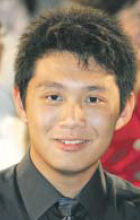Another Bites The Dust
Man dies of uterine cancer linked to kidney transplant <!-- google_ad_section_end(name=story_headline) -->
<!-- // .story-headline -->
- By Jennifer Peltz in New York
- From: <cite>AP </cite>
- May 28, 2010 2:25PM
<!-- // .story-info -->
<!-- // .story-header-tools -->
<!-- .story-header -->
<!-- // .image-frame -->
A New York man contracted uterine cancer after a kidney transplant from a woman already suffering with the cancer / AP.
Source: AP
<!-- // .caption -->
<!-- // .tabs .js-tabbed -->
<!-- // .article-media -->
<!-- google_ad_section_start(name=story_introduction, weight=high) -->VINCENT Liew waited five years for the kidney that was supposed to change his life. Instead, the organ ended it.
<!-- google_ad_section_end(name=story_introduction) -->
<!-- // .story-intro --><!-- google_ad_section_start(name=story_body, weight=high) --> The kidney came from a woman who had uterine cancer, but she and doctors didn't know it. Once her disease was discovered after the transplant, Mr Liew's doctors highly doubted it could spread to him.
But in seven months, Mr Liew was killed by cancer that his autopsy linked to the transplant. His death, the subject of a medical malpractice trial in which closing arguments were scheduled for today, is believed to be the only reported instance of uterine cancer apparently being transmitted by transplant, medical experts say.
The case has reignited questions about the sometimes hidden risks carried by transplanted organs, risks that transplant experts say they have worked to minimise but can't eliminate - but are worth taking for many patients.
<!-- // .story-sidebar --> Mr Liew, a 37-year-old from Singapore who worked in the Hong Kong Economic and Trade Office in New York, didn't know the chance he was taking with the February 25, 2002, transplant that held the promise of freeing the diabetic from three-times-a-week dialysis.
"He was very excited, very happy," his widow, Kimberly Liew, testified last week, according to the
Daily News. But, she said, he ended up with "a bomb in his body."
Donor Sandy Cabrera had died of a stroke about a day earlier. The 50-year-old had seemed healthy until she collapsed while checking e-mail at her Newburgh, New York, home, and she and her loved ones had no clue about her cancer, said her boyfriend, Michael Daniels.
"I feel real bad for the guy who got the kidney, but I'm telling you, no one knew she had cancer," Mr Daniels said in a telephone interview.
The doctors who treated her at St Luke's Cornwall Hospital in Newburgh didn't know either, until an autopsy found the uterine cancer days after her death, according to testimony.
The news didn't reach Mr Liew's New York City transplant surgeon, Dr Thomas Diflo, until April 17, 2002, according to testimony. It's unclear why the information didn't travel faster; St Luke's declined to comment, and the organisation that arranged the transplant, the New York Organ Donor Network, didn't immediately return a call yesterday.
A gag order has prevented all the parties from speaking about the case outside court.
Dr Diflo testified that he told Mr Liew the safest plan was removing the kidney, but the odds of Mr Liew developing the cancer were slim, given its origins in the female reproductive system.
"It would be extremely unusual for a man to get cancer of the uterus," Dr Diflo testified he told Mr Liew, according to the
Daily News.
Mr Liew decided to keep the organ, and Dr Diflo said he respected his patient's choice. Tests from May to August found no indication of cancer in the kidney, according to testimony.
Suffering from back pain, Mr Liew had Dr Diflo remove the kidney on August 29, 2002. Tumors were readily apparent, according to trial testimony, and Mr Liew died within a month.
His autopsy attributed his death to cancer that derived from the transplant and had genetically female cells, though it didn't specify the form of cancer. Dr Robert Gelfand, a NewYork-Presbyterian/Weill Cornell Medical Centre cancer specialist who reviewed the records for Mr Liew's widow, concluded Mr Liew died of uterine cancer.
Kimberly Liew is suing the transplant hospital, NYU Langone Medical Centre, saying doctors there should have removed the kidney as soon as they learned of the donor's cancer.
Ms Cabrera's family also donated her heart and other organs, Mr Daniels said. It's unclear who may have received the organs and how they have fared.
The federal Centres for Disease Control and Prevention estimate that one per cent of US organ transplants are suspected of transmitting illnesses, though data are sparse.
Some 23 transplant recipients in 2007 - out of about 28,000 recipients nationwide that year - were judged to have at least possibly contracted cancers, HIV, tuberculosis and other diseases from their donors, according to a 2009 article in the
American Journal of Transplantation. Twelve of the recipients died, according to the article, which examined reports made to the national Organ Procurement and Transplantation Network.
The organ network's policies call for screening potential donors for various diseases, including HIV and syphilis, as well as compiling as much information as possible on the would-be donor's medical and personal history to scout for diseases the tests might miss. Organs with known, active cancers generally aren't used.
But some cancers and other diseases can't always be detected in the short timeframe transplants requires, usually within a day, said Dr Jeffrey D Punch, the University of Michigan Health Systems' transplant chief. Or a donor may have been infected too recently for tests to find.
For many patients, those fears are outweighed by the potential benefits of a transplant that could vastly improve or save their lives.
More than 107,000 people nationwide were on transplant waiting lists as of yesterday, according to the United Network for Organ Sharing, which runs the national transplant network. More than 900 people have died while awaiting transplants this year.
<!-- google_ad_section_end(name=story_body) -->
<!-- // .story-body -->




















